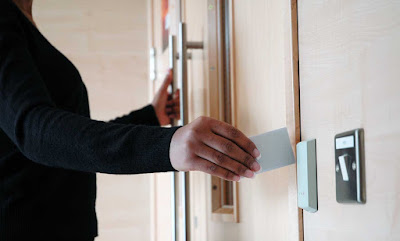Door Access Control Entry Devices--How will you get in?
Door Access Control Entry Devices
In all locking systems, the secure lock needs to be released by a physical object (such as a stand-alone lock, Key, Combination or fingerprint) or a combination of any or all. Examples include; Proximity readers, Keyswitch , Digital Keypads, and biometric readers (fingerprints). These devices are mounted on the exterior (secured side) either on the casing of the door (mullion mount) or on the wall near the door (gang mount). Examples of Entry Device types follow. 'Clicking' on any of the device photos will open a new window with direct access to pricing, and product datasheets for further and more detailed reference.
Stand-Alone Locks
As the name implies are an "all-in-one" access control system for a single-door. The lock powered by replaceable internal batteries can be unlocked by keypad, proximity card or a combination. The advantages of standalone locks are they can be installed and operational in minutes. Some offer hand-held readers that extract the audit trail from the lock. The disadvantages of stand-alone locks are they are stand-alone and not part of a broader networkProximity readers
are the most popular option in commercial access control. They are easy to use, and when cards are lost, it is a simple matter to deactivate them and issue new ones. They can also be combined with photo IDs for additional security. Proximity cards, which can work from one inch to three feet from a sensor, are the most common. Because there is no contact between the card and reader, they are very reliable and suffer a little wear and tear. They are also inexpensive. A specialized type of proximity card is the automobile tag, which allows access to a parking facility without requiring the driver to open their window or get out of the car. Automobile tags can work at hundreds of feet away from a sensor. Security access systems can use a magnetic stripe or barcode cards, as well, and these can be a money‐saving option if you already use one of these technologies for employee ID cards.Keyswitches
offer electronic auditing through a network while continuing to use a physical key to activate the lock.Keypads
are common for single door security access and less expensive systems. They are easy to use but less secure since users have a tendency to write down the entry code or to "lend" it to others. They also do not provide detailed audit trails until you provide unique codes to each individual.Biometric systems
rely on physical characteristics of the users for identification such as fingerprints, handprints, or even retinal scans. They are by far the most secure methods of access control. However, they are also considerably more expensive and can seem invasive to employees forced to use them constantly. Early models proved less unreliable outdoors, so they were not recommended for exterior security access.
For more information about access control system, please visit my "ShineACS Access Control Security" main website--It is a FREE website that you can download access control system knowledge and find right suitable access control products and solutions for your access control project.




This comment has been removed by the author.
ReplyDeleteAny suggested company for door access in Singapore? We need it for our company.
ReplyDelete